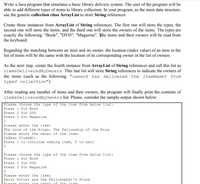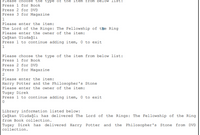
Write a Java
able to add different types of items to library collection. In your program, as the main data structure,
use the generic collection class ArrayList to store String references.
Create three instances from ArrayList of String references. The first one will store the types, the
second one will store the items, and the third one will store the owners of the items. The types are
exactly the following: "Book", "DVD", "Magazine". The items and their owners will be read from
the keyboard.
Regarding the matching between an item and its owner, the location (index value) of an item in the
list of items will be the same with the location of its corresponding owner in the list of owners.
As the next step, create the fourth instance from ArrayList of String references and call this list as
itemsDeliveredByOwners. This last list will store String references to indicate the owners of
the items (such as the following: "ownerX has delivered the itemNameY from
typeZ collection").
After reading any number of items and their owners, the program will finally print the contents of
itemsDeliveredByOwners list. Please, consider the sample output shown below
please help me to solve this


Trending nowThis is a popular solution!
Step by stepSolved in 3 steps with 2 images

- Write a Java program using methods and arrays. Create “HW9_lastname.java” program that: Prints a program title Creates a table with grades for our class students and initializes grades with random values Finds the largest grade for every student Displays the following information: Student name: CIS 232 Introduction to Programming Programming Project 9 Due Date: November 9, 2020 Instructor: Dr. Lomako ASSIGNMENT GRADES HW1 HW2 NW3 HW4 HW5 HW6 HW7 Student Name _______________________________________________________ 0001 0076 0078 0068 0003 0012 0048 Adams 0033 0042 0035 0020 0021 0058 0060 Aimuengheuwa 0013 0021 0037 0099 0025 0098 0060 Bennett 0068 0089 0007 0051 0083 0057 0080 Bowen 0062 0078 0083 0013 0023 0043 0098 Brown 0052 0003 0033 0091 0003 0031 0080…arrow_forwardWrite the InputLicenses() function in the Database class. Within InputLicenses(), use cin to read pairs of inputs, character currRenewable and string currState, until 'D' is read from input. Create a License object with currRenewable and currState as arguments and append the object to vector licenseList. Ex: If the input is N MS N NY Y NE Y HI D, then the output is: License renewable: N, State: MS License renewable: N, State: NY License renewable: Y, State: NE License renewable: Y, State: HI 1 #include 2 #include 3 using namespace std; 4 5 class License { 6 7 8 9 public: void Set Details (char newRenewable, string newstate); void Print () const; Check private: 10 11 12 }; 13 14 void License::SetDetails (char newRenewable, string newState) ( 15 16 17) 18 char renewable; string state; renewable state newState; newRenewable; Next level 2 CS Scanned with CamScanner 3 Feedback?arrow_forwardusing java programming code the followingarrow_forward
- True or False? In Java, an array is a primitive type that need not be instantiated.arrow_forwardAssume the existence of a Widget class that implements the Comparable interface and thus has a compareTo method that accepts an Object parameter and returns an int. Write an efficient static method, getWidgetMatch, that has two parameters. The first parameter is a reference to a Widget object. The second parameter is a potentially very large array of Widget objects that has been sorted in ascending order based on the Widget compareTo method. The getWidgetMatch searches for an element in the array that matches the first parameter on the basis of the equals method and returns true if found and false otherwise.arrow_forward1 import java.util.Random; 2 3 4 5 6- 7 8 9 10 11 12 ▼ import java.util.StringJoiner; public class preLabC { public static MathVector myMethod(int[] testValues) { // Create an object of type "MathVector". // return the Math Vector Object back to the testing script. return VectorObject; 13 14 15 } } ▸ Comments Description The MathVector.java file contains a class (Math Vector). This class allows you to create objects in your program that can contain vectors (a 1D array) and perform actions on those vectors. This is useful for doing math operations like you would in your linear algebra class. Your method should evaluate against two tests. What do you need to do in this exercise? You need to create an "instance" of the MathVector object, VectorObject, in your method. If you do this correctly, your method will accept a 1D array of integers, testValues, feed it into the VectorObject and then return the VectorObject. If you look in the file MathVector.java you'll see that this is one way in…arrow_forward
- The program first reads integer cityCount from input, representing the number of pairs of inputs to be read. Each pair has a string and a character. One City object is created for each pair and added to vector cityList. Write the PrintSelectedCities() function in the SmallTowns class using Print() to output all the City objects with tour status equal to 'N'. Ex: If the input is: 4 Sundance N Adomstown N Hum Y Hanna Y then the output is: City: Sundance, Tour: N City: Adomstown, Tour: N Note: The vector has at least one element. #include <iostream>#include <vector>using namespace std; class City {public:void SetNameAndTour(string newName, char newTour); char GetTour() const; void Print() const;private:string name;char tour;}; void City::SetNameAndTour(string newName, char newTour) {name = newName;tour = newTour;} char City::GetTour() const { return tour;} void City::Print() const { cout << "City: " << name << ", Tour: " << tour <<…arrow_forwardThe following is the specification for the constructor of a EmailFolder class: /*** Creates a new EmailFolder with the given label** @precondition label != null AND !label.isEmpty()* @postcondition getLabel()==label*/public EmailFolder(String label) Assume the variable folders is an array list of EmailFolder objects. Write code to add a new EmailFolder to the list.arrow_forwardThe code given below represents a saveTransaction() method which is used to save data to a database from the Java program. Given the classes in the image as well as an image of the screen which will call the function, modify the given code so that it loops through the items again, this time as it loops through you are to insert the data into the salesdetails table, note that the SalesNumber from the AUTO-INCREMENT field from above is to be inserted here with each record being placed into the salesdetails table. Finally, as you loop through the items the product table must be update because as products are sold the onhand field in the products table must be updated. When multiple tables are to be updated with related data, you should wrap it into a DMBS transaction. The schema for the database is also depicted. public class PosDAO { private Connection connection; public PosDAO(Connection connection) { this.connection = connection; } public void…arrow_forward
- We have a parking office class for an object-oriented parking management system using java Implement the following methods for our class Add equals and hashCode methods to any class used in a List. Add a method to the Parking Office to return a collection of customer ids (getCustomerIds) Add a method to the Parking Office to return a collection of permit ids (getPermitIds) Add a method to the Parking Office to return the collection of permit ids for a specific customer (getPermitIds(Customer)) The above methods are not included in the parking office class of our class diagram. I have attached class diagrams with definitions of related classes in our system (i.e car, customer, .....)arrow_forwardThe two classes you will create will implement the operations defined in the interface as shown in the UML class diagram above. In addition, BinarySearchArray will implement a static method testBinarySearchArray() that populates the lists, and lets the user interactively test the two classes by adding and removing elements. The parameter BinarySearch can represent either class and tells testBinarySearchArray which class to test. Steps to Implement: 1) To get started create a new project in IntelliJ called BinarySearch. Add a class to your project called BinarySearchArray. Then add another class BinarySearchArrayList and an interface called BinarySearch. The interface BinarySearch includes public method stubs as shown in the diagram. You are allowed to add BinarySearchArrayList to the same file as BinarySearch but don't add an access modifier to this class, or for easier reading, you can declare the classes in separate files with public access modifiers. Only the class…arrow_forwardDesign a class called Post. This class models a StackOverflow post. It should have properties for title, description and the date/time it was created. We should be able to up-vote or down-vote a post. We should also be able to see the current vote value. In the main method, create a post, up-vote and down-vote it a few times and then display the the current vote value.arrow_forward
 Computer Networking: A Top-Down Approach (7th Edi...Computer EngineeringISBN:9780133594140Author:James Kurose, Keith RossPublisher:PEARSON
Computer Networking: A Top-Down Approach (7th Edi...Computer EngineeringISBN:9780133594140Author:James Kurose, Keith RossPublisher:PEARSON Computer Organization and Design MIPS Edition, Fi...Computer EngineeringISBN:9780124077263Author:David A. Patterson, John L. HennessyPublisher:Elsevier Science
Computer Organization and Design MIPS Edition, Fi...Computer EngineeringISBN:9780124077263Author:David A. Patterson, John L. HennessyPublisher:Elsevier Science Network+ Guide to Networks (MindTap Course List)Computer EngineeringISBN:9781337569330Author:Jill West, Tamara Dean, Jean AndrewsPublisher:Cengage Learning
Network+ Guide to Networks (MindTap Course List)Computer EngineeringISBN:9781337569330Author:Jill West, Tamara Dean, Jean AndrewsPublisher:Cengage Learning Concepts of Database ManagementComputer EngineeringISBN:9781337093422Author:Joy L. Starks, Philip J. Pratt, Mary Z. LastPublisher:Cengage Learning
Concepts of Database ManagementComputer EngineeringISBN:9781337093422Author:Joy L. Starks, Philip J. Pratt, Mary Z. LastPublisher:Cengage Learning Prelude to ProgrammingComputer EngineeringISBN:9780133750423Author:VENIT, StewartPublisher:Pearson Education
Prelude to ProgrammingComputer EngineeringISBN:9780133750423Author:VENIT, StewartPublisher:Pearson Education Sc Business Data Communications and Networking, T...Computer EngineeringISBN:9781119368830Author:FITZGERALDPublisher:WILEY
Sc Business Data Communications and Networking, T...Computer EngineeringISBN:9781119368830Author:FITZGERALDPublisher:WILEY





